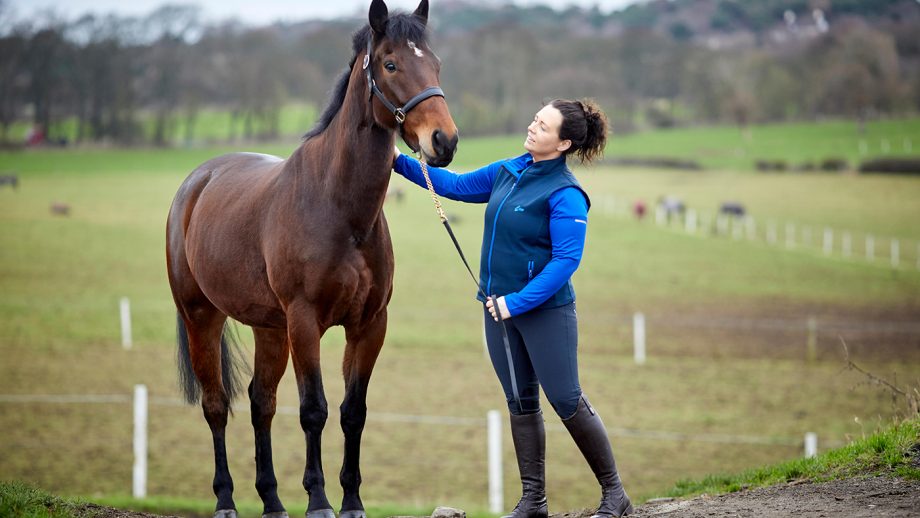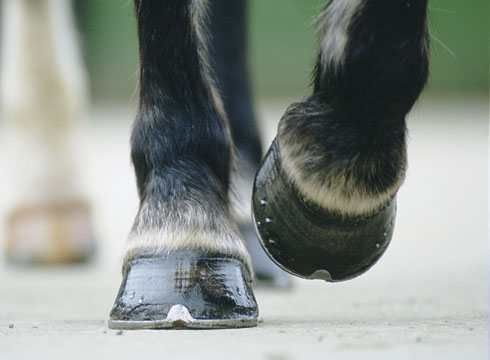So you think you’ve found the right horse, but you’re unsure whether or not to get it vetted, what type of vetting to have and which vet to use. Don’t worry, we are here to help to navigate what can be a stressful situation for all involved...
Pre-purchase equine vettings are designed to provide a buyer with a vet’s expert opinion on whether the horse they are looking to buy is physically suitable for the job it is intended for. Whenever possible it is recommended a purchaser attends the vetting, so they can see and discuss any potential issues that arise, and that their normal vet is used, if that is an option.
Pre-purchase equine vettings: Two stage | Five stage | Optional extras | Results | Further reading
If this is not possible then using a vet who does not have links with the seller or the horse would avoid any conflicts of interest. If you are looking for a vet outside your local area, then we recommend you do some research online before deciding which individual to use. Local contacts including social media groups can be a good place to seek recommendations, or ask your own vet. Where possible try to choose a vet who has a similar approach to risk as yourself, so it is worth speaking to the vet in advance to ascertain this.
In areas where there is only one specialist equine veterinary practice, unless the buyer’s vet is prepared to travel (and the buyer is prepared to pay extra for them to do so) the only local choice may be to use a vet from the same practice as used by the seller. This could be beneficial to the buyer as the seller’s own vet should only undertake the task if they can reveal all of the horse’s history, although it does have potential to cause awkwardness for the vet, so they may prefer not to do so. Should the horse’s regular vet decline to undertake the vetting then the seller should take a moment to consider why that might be – while the reason could be entirely innocent, it equally may not be.
It is important to understand that the vet typically has less than a couple of hours to assess the horse during a pre-purchase equine vetting. Vets do not possess a crystal ball to predict the future soundness of a horse, nor their likelihood of picking up an injury, although the vetting is designed to show up signs of an existing health problem. The vetting is an assessment of that horse on that day and cannot provide a long-term guarantee.
It is extremely difficult for the vet to obtain an accurate picture of the health and soundness of a mature horse that is out of work. It helps hugely to have a performance record and evidence that the horse is in regular work at the time of the vetting, or else you should consider carefully why the horse has been rested.
Vets are not there to provide advice as to the suitability of a horse for an individual owner or rider, nor whether the temperament, type or ability of the equine is suitable for the level and type of work the buyer intends to pursue. Advice on this matter should be obtained from a trainer or other equestrian professional prior to the vetting if needed.
The seller is responsible for providing the horse’s passport for verification, together with any documents regarding the horse’s breeding. In addition to a valid passport, from October 2020 all horses and ponies must be microchipped. The vet should be able to confirm the horse’s identity from its passport markings and the microchip. The passport should include information about the horse’s age, which can also be checked by the vet against the horse’s teeth, although ageing a horse from its dentition is not always that accurate, especially in older horses. If the height of a horse or pony is important, then an accurate height record should be obtained by the buyer via the Joint Measurement Board. A vetting will not include verification of a horse’s reported height.
Most insurance companies require a two- or five-stage equine vetting, undertaken often no more than 14 days before a policy is taken out, in order to insure a new horse. There are no set rules about this, so it is important to do your research with potential insurers before you book the vetting to ensure it is appropriate for your, and their, needs.
Two-stage equine vettings
Stage one is observation of the horse at rest in his stable. The vet notes the horse’s breathing rate, listens to his heart and examines its eyes. The examination of the eyes requires a sufficiently dark stable for the eyes to be fully checked out. The horse is then taken outside to examine the skin, limbs and teeth in good light. The inspection of his teeth is simply to confirm approximate age – a full dental examination is not normally conducted. If you want to know if the horse needs its teeth done, then you will need to ask the vet to check for this.
The aim is for the vet to look all over the horse’s body. Any lumps and bumps denoting old injuries, or sarcoids or masses on the body, should be noted. The vet should view and preferably palpate every inch of skin to check for abnormalities, even under the belly. It can be challenging to do this properly in a poorly handled youngster, or a horse with a thick winter coat or which is ungroomed and dirty. Any conformational defects will be observed and may be discussed at this point.
Stage two involves walking and trotting up the horse in a straight line on a firm, flat surface, looking for signs of lameness. Vets will usually conduct flexion tests on the joints of the lower limbs at this point depending on the age and temperament of the horse. If the vet is happy with the findings, the horse should be trotted on a circle each way, ideally on both hard and soft surfaces, and asked to back up.
If only a two-stage vetting is required, then the examination will end here and the vet will advise on whether or not he feels the horse is suitable for the type of work required from the limited information he has available. However, for a five-stage equine vetting the examination will continue with assessing the horse during exercise.
Five-stage equine vettings
Stage three is the exercise phase — this section is to identify if there are any potential issues with the cardiovascular system (heart and lungs and upper respiratory tract) when they are placed under stress so the horse is required to undergo strenuous work. It is also a chance to look for any gait anomalies or lameness that was not evident in stage two. In most cases the horse is worked under saddle and will be asked to do some fast canter work once suitably warmed-up. In the case of a young or unbacked horse, this stage can be undertaken on the lunge or via loose schooling. If the horse is not ridden, it may be harder to assess the back fully. It needs to be established in advance who is going to ride the horse and what facilities are available. A good rider can present a horse more favourably, so it may be sensible for the purchaser to ride their potential new horse themselves for this stage of the vetting.
Stage four is a period of rest where the horse’s recovery after fast work is assessed. This is also a good time for the vet to examine the horse’s official paperwork, including its passport, which must be available at the time of the pre-purchase examination.
Stage five is the final trot-up examination. This is to show whether the horse has stiffened up after the strenuous exercise or whether the work has given rise to any gait anomalies that were not apparent at stage two. Some vets will perform flexion tests and lunge the horse on a hard surface once again, and/or back it up and turn it in tight circles too.
Optional extras
Most vets recommend taking a blood sample from the horse during the vetting. This can be kept for six months and then examined should the buyer suspect that the horse was under sedation or receiving pain relief at the time of the viewings and vetting.
In addition to the standard vetting process, some buyers may ask to have x-rays taken of joints or the horse’s neck and back or for the limbs to be scanned to look for potential damage of the tendons or ligaments. Each of these examinations will carry significant additional costs for the buyer.
Increasingly livery yards are asking owners to prove their horses are strangles-free prior to arrival so buyers may also ask their vet to take a swab or more likely a blood sample to check for a history of strangles, if they are confident about proceeding with the purchase of the horse.
Do horses pass or fail vettings?
Once the examination is complete, the vet will give their opinion on whether the horse is suitable for the job it is intended for.
It is important to understand that vets no longer ‘pass’ or ‘fail’ a horse during an equine vetting. The official wording on the vetting certificate is: “In my opinion, on the balance of probabilities, the conditions reported do/do not prejudice this horses suitability for purchase to be used for…”, which emphasises that as much information as possible has been noted and considered before a decision has been made.
While a few horses will receive a clean bill of health, in most cases the vet will find one or more issues and will then grade the degree of risk so the buyers can decide whether or not to go ahead with the purchase.
It is likely that anything noted on the vetting certificate will be excluded from insurance cover, so even if the vet thinks the horse is suitable for the intended work, the buyer should share their vetting with the insurance company before agreeing to buy the horse.
If a vetting does raise a soundness or other health issue, the vetting is not the time to undertaken a thorough investigation into what that problem is. This is something for the seller to look into with their own vet at a later date.
It is important to understand that vettings can be a stressful time for all involved. The seller wants to sell the horse, the buyer wishes to buy the horse – both parties want the horse to be approved by the vet. This puts significant pressure on the vet, but they cannot allow themselves to be swayed from their impartial and pragmatic opinion – to do so would not only be unprofessional, but it could potentially result in disappointment all round, or even legal action if they approve a horse that later proves to be unsuitable for the purpose.
- Pre-purchase flexion tests: are they fair?
- Should horse owners still buy despite bad X-rays?
- Investigating a horse’s health before buying
You may also be interested in…

Buying a horse: Horse & Hound’s ultimate step-by-step guide

10 reasons why buying a new horse might be the most stressful thing ever
Horse shopping should be fun… But but it can also considerably raise your blood pressure. Here's why...

Buying a horse? Five vital conformation tips to consider first
Thinking of investing in a horse with a conformation quirk? Andrea Oakes finds out what to consider before you take

Buying a horse at an elite sale or auction: H&H explains all you need to know

Subscribe to Horse & Hound magazine today – and enjoy unlimited website access all year round


